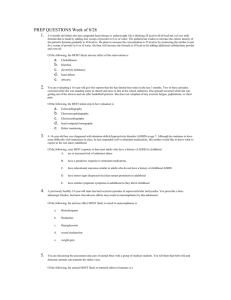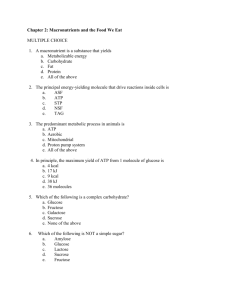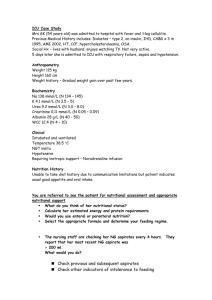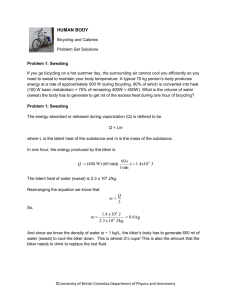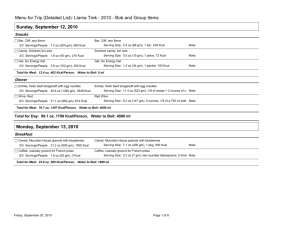MY FOOD INTAKE: 5 step approach
advertisement
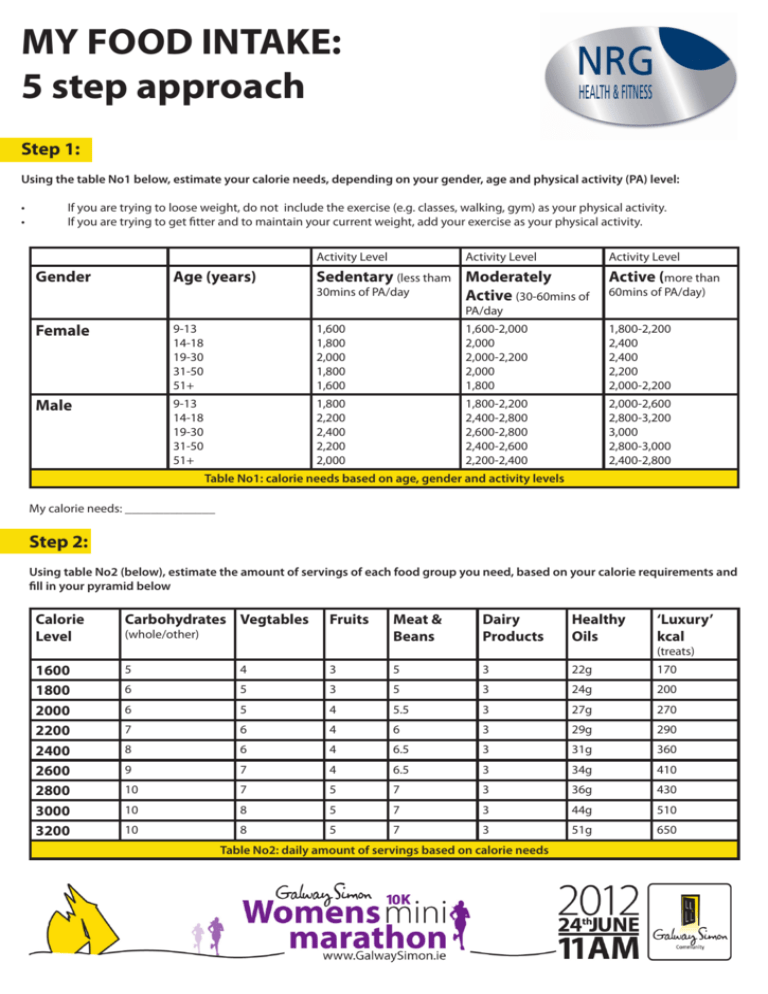
MY FOOD INTAKE: 5 step approach Step 1: Using the table No1 below, estimate your calorie needs, depending on your gender, age and physical activity (PA) level: • • If you are trying to loose weight, do not include the exercise (e.g. classes, walking, gym) as your physical activity. If you are trying to get fitter and to maintain your current weight, add your exercise as your physical activity. Activity Level Gender Age (years) Activity Level Activity Level Sedentary (less tham Moderately 30mins of PA/day Active (30-60mins of Active (more than 60mins of PA/day) PA/day Female 9-13 14-18 19-30 31-50 51+ 1,600 1,800 2,000 1,800 1,600 1,600-2,000 2,000 2,000-2,200 2,000 1,800 1,800-2,200 2,400 2,400 2,200 2,000-2,200 Male 9-13 14-18 19-30 31-50 51+ 1,800 2,200 2,400 2,200 2,000 1,800-2,200 2,400-2,800 2,600-2,800 2,400-2,600 2,200-2,400 2,000-2,600 2,800-3,200 3,000 2,800-3,000 2,400-2,800 Table No1: calorie needs based on age, gender and activity levels My calorie needs: ______________ Step 2: Using table No2 (below), estimate the amount of servings of each food group you need, based on your calorie requirements and fill in your pyramid below Calorie Level Carbohydrates Vegtables Meat & Beans Dairy Products Healthy Oils ‘Luxury’ kcal 1600 1800 2000 2200 2400 2600 2800 3000 3200 5 4 3 5 3 22g 170 6 5 3 5 3 24g 200 6 5 4 5.5 3 27g 270 7 6 4 6 3 29g 290 8 6 4 6.5 3 31g 360 9 7 4 6.5 3 34g 410 10 7 5 7 3 36g 430 10 8 5 7 3 44g 510 10 8 5 7 3 51g 650 (whole/other) Fruits Table No2: daily amount of servings based on calorie needs (treats) Step 3: Get familiar with the food groups and serving sizes. What’s the difference between a portion ands a serving? • • A portion is the amount of food you CHOOSE to eat. There is no standard portion size and no single right or wrong portion size. A serving is a standard amount used to help give advice about how much to eat, or to identify how many calories and nutrients are in a food. CARBOHYDRATES (GRAINS AND POTATOES) 1 serving is: • • • • • • • • • • • • 1 cup (30-40g) of ready-to-eat cereal (1/2 of standard cereal bowl) 1 slice of bread ½ roll 1/2 cup pasta, noodles or rice (about size of a tennis ball) 1/2 average bagel: (3-4 inches diameter) ½ hamburger bun 1 Medium baked potato:( about the size of a computer mouse) 10 French fries (baked) 1 cup of mashed potatoes 1 small tortilla wrap 2-3 crackers (Ryvita, rice cakes) 4 oat cakes Remember: At least 50 % of daily grain intake should come from whole grain products VEGETABLES: 1 serving is: • • • • • • 1/2 cup of chopped raw vegetables (as much as you can fit in your palm) 1 cup of lettuce: (about four leaves) 5-6 baby carrots 1 small ball of salad (raw leafy greens) 1 glass of vegetable juice A large peace of broccoli, cauliflower (size of light bulb) Remember: Add vegetables with every meal. Your dinner plate should consist of ½ vegetables/ ¼ protein/ ¼ complex carbohydrates HEALTHY OILS: 1 serving is: • 1 tablespoon of vegetable oils or 1 tablespoon of seeds FRUITS: 1 serving is: • • • • • 1 medium apple or orange (about the size of a tennis ball) 1/2 cup dried fruit: e.g. raisins, apricots, mango (a small handful) 1 cup of chopped fruit or 100% fruit juice 2 small fruits (e.g. Satsuma’s) 1 handful of berries PROTEIN: (Meat, fish and beans) 1 serving is: • 1 oz. meat, poultry or fish (about the size of a matchbox) • 2 Tbs. peanut butter • 1/4 cup cooked or canned legumes (beans and peas) • ½ ounce of nuts or seeds (small handful) • 1 egg If you eat… • Meat size of a deck of cards or bar of soap (3 oz) - 3 servings (recommended for your dinner plate) • Fish: size of a checkbook (3 oz) – 3 servings (recommended for your dinner plate) • Meat: size of a thin paperback book (8 oz) – 8 servings! DAIRY PRODUCTS: 1 serving is: • • • • • • • 1 glass of milk 1 yogurt (125 ml) 1 yogurt drink ½ cup of cottage cheese 1oz of cheddar-type cheese (about a size of the match box ) 2 cheese slices 2 small pot of fromage frais All servings are consumed without sugars and fats or using low fat/ lean options (meat, dairy products). If you consume full fat or with added sugars, reduce your ‘Luxury calorie’ amount by at least 50%. MY TREATS: not more than 10-15% of total daily calorie intake ALCOHOL • Large glass of red or white (dry) wine (350ml) - 240 kcal • Bottle of red or white (dry) wine: 550-600 kcal • Bailey’s Irish cream shot (50g) – 160 kcal • Bacardi breezer (bottle) 150-190 kcal • Bottle of Heineken (larger) (330 ml) - 85 kcal • Pint of Heineken (larger) (600 ml) -150 kcal • Pint of bitter beer (600 ml) – 195 kcal • Small bottle of sider (330 ml) – 120 kcal • Pint of cider (600 ml) – 240 kcal • Coor light bottle (330ml) – 85 kcal Remember: to burn ½ of large glass of wine or a pint of beer you need to do an extra 30 min of brisk walking! FATS: • • • • • • Butter (5 g sachet or teaspoon) - 50 kcal Low fat spread (5 g or teaspoon) – 20 kcal Vegetable Oil (5 g or 1 tablespoon) – 45 kcal Mayonnaise (full fat) 15 g (1 tablespoon) Mayonnaise (light) 15 g (1 tablespoon) – 44 kcal Mayonnaise (extra light) (1 tablespoon) – 14 kcal ICE CREAM: • Ice cream (50 mg or size of tennis ball) – 50-150 kcaL PIZZA: • • • • • • • 1slice of take-out pizza (9”5 size) – 170-190 kcal Garlic pizza bread (per slice) 117 kcal Fast Food big burger – 493 kcal portion of french fries – 206 kcal milkshake -383 kcal hamburger – 253 kcal Step 4: Fill in your pyramid (amounts of daily servings and your favorite foods) My Treats My good oils My dairy products My Protein (meat & beans) My Fruits My Vegtables My Carbohydrates

